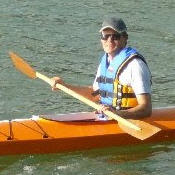The Mk I version was hopeless, so I angled the bunks a bit to provide the Mk II, which also shed its load on the way to the beach. The photo shows the more elaborate Mk III with wide, raised bunks set further forward on the boat to help with balance, and the bungee cords replaced by nylon cam-lock straps. This also failed while taking the kayak down for a quick paddle out to 'VESPER', a schooner moored about 1 km away and which I originally suspected to be a remnant of New Zealand's fleet of trading scows. I know now that it's not a true scow, but need to research a little more to see if there is any link at all to the scows of old. Either way, I ended up carrying the kayak back, along with the trolley and was nearly late for a night out as a result.

The Mk IV trolley is sitting in the garage waiting to be tested, but as I write the rain is torrential and a gale warning is in force, so it will have to wait in the garage a little longer.
My building and boating activities have been somewhat curtailed of late. For the last 4 weeks I've been acting as full time tour guide to my parents, over on a visit from the UK. I did manage to get away yesterday evening however, to take part in a race on board my friend and neighbour's Beale 33' cruiser/racer. Winds were up 15 - 20 knots and with only two of us on board, it was quite exciting. We didn't do well, but that was mainly down to confusion at the start when the skipper accidentally reset his stop watch and so we had only the 1 minute gun to go by, crossing the start over 30 seconds late. I learned a lot during the race though, and also managed to use some of what I've read over the past few months, all good practice for when I build my own boat.



